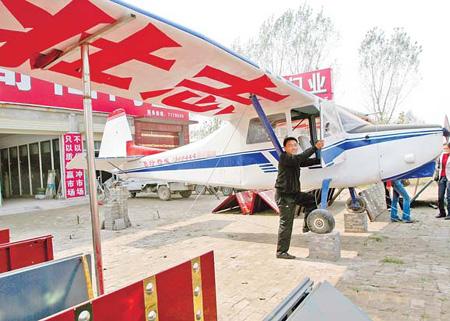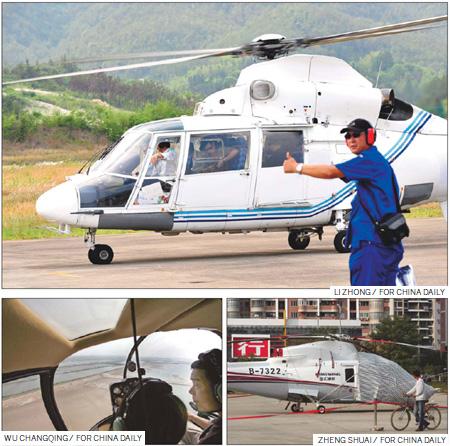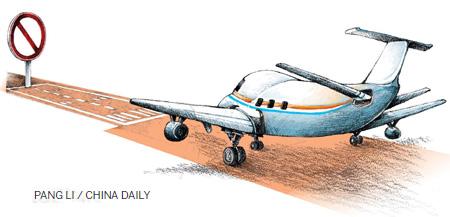 Farmer entrepreneur He Zhuangzhi, from Neihuang county, Henan province, poses with his Haiyan-650c plane in this file photo taken in October 2008.[Photo/China Daily]
Farmer entrepreneur He Zhuangzhi, from Neihuang county, Henan province, poses with his Haiyan-650c plane in this file photo taken in October 2008.[Photo/China Daily]China's wealthy are trying to dodge strict aviation regulations. Wang Ying reports from Shanghai.
It was a hot July night and the usually busy runway at Hangzhou's Xiaoshan International Airport had been silent for almost an hour. Inside, curious travelers peered out of the windows as rumors quickly spread that their flights were grounded because of a UFO.
Unfortunately for those expecting little green men, the explanation from authorities several days later was far from mysterious: It was a private jet taking a "black flight".
China's strict airspace policy bans all pilots from taking to the skies without prior clearance from aviation officials. Yet, many private aircraft owners - largely parvenus who have benefited from three decades of soaring economic growth - are cutting through the red tape.
"You know, most UFO sightings over the Chinese mainland are actually (unapproved) black flights being made by private owners," said an industry insider who did not want to be identified.
Although there are plans to ease flight restrictions, experts warn that black flights promise not only chaos for airports, but also disaster.
Sightings of at least nine UFOs have been reported across China since June this year, including in Hunan, Yunnan, Sichuan, Shanxi and Shandong provinces and the Xinjiang Uygur autonomous region.
More than 20 scheduled flights were delayed in Hangzhou, capital of Zhejiang province, in July, with more grounded in a similar high-profile incident at Baotou Airport in the Inner Mongolia autonomous region on Sept 11.
Breaking the limit
Rule-breaking pilots face fines of up to 100,000 yuan ($15,000) from the Civil Aviation Administration of China (CAAC) if caught, although the penalty has so far not proved much of a deterrent to the swelling ranks of China's nouveau riche.
Xu Weijie has been flying since signing up with a Shanghai pilot school in 2004. A native of Wenzhou, a wealthy industrial city in Zhejiang, he admitted he flies an average of 200 hours every year but rarely logs a flight plan with authorities.
"What makes matters worse is that the aircraft I use are (mostly) light-sport planes which are barred from Chinese airspace under the regulations," said the 32-year-old, who owns 10 planes and a Hummingbird 260L helicopter.
"It means I can only take off and land in remote areas, far out of sight of the general public and officials," added the businessman, who sells self-build aircraft kits.
Others, however, argue that flouting the rules is part of a crusade to raise awareness.
Guan Hongsheng, 44, who runs a successful company in Wenzhou that exports clothes, hats, shoes and construction materials, said black flights are his way of standing up against an "outdated regulation".
To be cleared to fly, aircrafts must be registered with local CAAC offices, which check that the model is approved for Chinese airspace. Pilots also have to submit flight plans for every proposed journey, including times and the route to be taken.
Guan, who owns five planes - three in China and two in the United States - and is deputy director of the Wenzhou Lucheng Hailukong Club, complained that the application process is too complicated and too time-consuming.
Flight permits depend on the route and how many local CAAC departments need to be involved. If it is just one, the application can be processed in a day; otherwise pilots can be made to wait up to a week for clearance.
The price of permits, which can cover up to seven days, is also variable. For example, to fly between Xi'an in Shaanxi and Shanghai costs about 1,000 yuan a time.
"In March, our club flew two Rotorway Exec 162F helicopters for 20 minutes without official approval and were later fined 20,000 yuan by the Zhejiang CAAC," said Guan, whose club has more than 100 members, including 80 percent from the so-called "rich second generation".
"There always needs to be one person challenging an outdated regulation. I'm not scared to take the initiative," said the entrepreneur.
Yi Hong, marketing director for Xi'an Zhongfei Aviation Club, however, feels the harsh restrictions are necessary to prevent potential disasters. "If a UFO is spotted near an airport, (air traffic controllers) have no option but to delay or suspend (the departure and arrival of) passenger aircraft so as to avoid a mid-air collision," she said.
Opening the skies
For pilots like Xu and Guan, hope arrived last month in the form of a joint announcement by the State Council and Central Military Commission that the nation's low-altitude airspace will be "gradually opened" to promote the general aviation industry.
Under the move, private aircraft will be automatically cleared to fly at heights of up to 1,000 meters.
General aviation refers to all flights other than military and scheduled airline and cargo flights, both private and commercial. It covers a wide range of activities, including flight training, air rescue and aerial firefighting, as well as gliding and skydiving.
"It's great news," said Wang Bin, who runs a framing company in Yiwu. "I'm really looking forward to it."
The businessman bought his first plane from France in 2006 on the recommendation of an American friend. However, by the end of the following year, he calculated that, because of the restrictions and maintenance costs, he had spent more than 20 million yuan for just 36 hours of flight time.
Industry insiders also welcomed the announcement, while some of the more optimistic suggested that opening China's airspace will provide the next economic growth engine in general aviation.
"In North America, general aviation is very popular; there are 19,000 airports, 590,000 pilots and 224,000 aircrafts for the use of general aviation in the US alone," said Zhang Yan, Party secretary of the discipline working committee at Xi'an Yanliang National Aviation High-Tech Industrial Base in Shaanxi province.
"The industry in the US turns out more than $150 billion revenue each year, accounting for nearly 2 percent of the country's GDP," he added.
In contrast, there are fewer than 1,000 aircrafts, 2,000 pilots and 300 airports for the use of the general aviation in China. Meanwhile, although 60 percent of planes in the US are privately owned, the percentage in China is only about 20 percent.
"This gap gives (companies) a great opportunity once the low-altitude airspace is opened. It will become the nation's new economic growth engine," said Zhang, who is also director of the Shaanxi Northwest General Aviation Association.
He explained that the industry probably has the highest rate of business turnover, with every 1 yuan of investment yielding a return of 10 yuan. The ratio for the automotive industry is 1:4.
Employment boost
Experts say another potential benefit is that every job created could bring about 12 more employment opportunities thanks to the long industrial chain, which includes aircraft and parts manufacturing, sales, maintenance and reparation and pilot training.
According to Lu Yongguang, an industrial analyst for Central China Securities, the "private air service is growing rapidly", although "administrative hurdles" are standing in its way.
Zhang agreed and said China is probably the only country in his impression that has low-altitude airspace restriction.
"The whole industry is moving forward fast, so the opening of airspace is a trend," he added. "However, strict and scientific management is key to the smooth development of the general aviation industry."
Some investors are already eyeing the many opportunities in general aviation.
Niu Yankai this year founded Zhejiang Pinghu Jiulongshan Aviation Club after studying and comparing the markets in China and overseas.
"For the first stage we'll invest 60 million yuan into Jiulongshan Airport (in Zhejiang) and then we'll start to recruit helicopter pilots for both adventure and exploration services," he said. "Meanwhile, we're also in talks with US partners to offer more facilities at the club."
Zhang Feng, director of the Aircraft Owners and Pilots Association, said there are more than 30 registered aviation clubs and many more unregistered ones across the country. He suggested that a lot of effort will be needed to help Chinese businesses to take advantage of the loosened airspace restriction, such as improving ground infrastructure construction, flight management systems and pilot training.
A report released in September by aircraft manufacturer Boeing predicts that China will need 70,600 pilots and 96,400 aircrew members in the next 20 years. Wenzhou pilot Xu in believes it will not be a problem getting more people on board.
"I believe everybody has dreamed of flying at least once in their life because it's a human nature to push past the limits," he said. "The experience of controlling the aircraft and flying in the sky is amazing. Nothing can compare with that feeling."
Yu Ran in Shanghai contributed to this story.
 Clockwise from top: People board a helicopter to enjoy the first flight of the Friends of Wind Club on May 16, 2009, when the group was established in Hangzhou, Zhejiang province; A cyclist looks at a S-76 helicopter in downtown Fuzhou, capital of Fujian province, on Feb 11 this year. It is owned by Shanghai-based entrepreneur Zou Jianming; Li Linhai, another entrepreneur in Shanghai, flies his helicopter on June 29, 2005. Li bought the 4-million-yuan aircraft in the US.
Clockwise from top: People board a helicopter to enjoy the first flight of the Friends of Wind Club on May 16, 2009, when the group was established in Hangzhou, Zhejiang province; A cyclist looks at a S-76 helicopter in downtown Fuzhou, capital of Fujian province, on Feb 11 this year. It is owned by Shanghai-based entrepreneur Zou Jianming; Li Linhai, another entrepreneur in Shanghai, flies his helicopter on June 29, 2005. Li bought the 4-million-yuan aircraft in the US.








